SHELBURNE, ON No proposals. No resumes. No deadlines. Much like the small, independent farm on which it’s hosted, the Don Blanche residency is an anomaly in an increasingly globalized world. Created in 2009 by Don Miller and Christine Swintak as “a gift to artists,” Don Blanche is a ten-day residency that takes place each summer near Shelburne, Ontario, a small town two hours north of Toronto.
Centred in and around a huge 6,000-square-foot building that Miller constructed from century-old dismantled barns and an array of purposefully placed found window panes (Swintak has affectionately nicknamed it the “Frankenbarn”), Don Blanche hosts up to 80 artists who come from across the country to work on projects. There is no running water, and limited electricity comes from solar panels and wind turbines. Most participants camp outside or sleep in a dorm in a wing of the barn.
It may sound like a modern-day version of Susanna Moodie’s Roughing It in the Bush, but Don Blanche’s rough-and-ready approach attracts an impressive roster of contemporary artists and curators; Diane Borsato, FASTWÜRMS, Michelle Jacques, Olia Mishchenko, Ben Portis, Geoffrey Pugen and Nicholas Pye are among its participants.
Miller and Swintak first met in 1999 at the Nova Scotia College of Art and Design. Both artists, their way of alleviating the pressures of international residencies was to reverse the trend of the cushy “professional” residency by challenging artists to manage their most basic needs and seeing what kinds of creative solutions and artistic strategies would result. “Building basic amenities becomes part of the creative project,” Miller explains.
Though it recalls the artistic hangouts of the 1960s and 1970s— such as the Maplewood Mudflats squats in North Vancouver, or Michael Morris and Vincent Trasov’s Babyland retreat at Robert’s Creek, BC—Don Blanche is less an idealistic hippie haven than an open-air artist-run centre. In an “office” space that Swintak has carved out inside the Frankenbarn, three large blackboards keep the residency organized, charting arrivals and departures, a list of programs and projects started on the property, and participants’ material and equipment requests. Funding for materials comes largely from an Ontario Arts Council grant and is given out on a first-come, first-served basis from two tin boxes on Swintak’s desk. On Labour Day weekend, Miller and Swintak present a public open house that marks the end of the residency. In a pithy turn of phrase that could easily work as Don Blanche’s motto, Swintak says, “Our curatorial premise is ‘yes.’”
This is an article from the Fall 2011 issue of Canadian Art. To read more from this issue, please visit its table of contents.

 Don Miller and Christine Swintak outside the Don Blanche residency barn, June 2011 / photo Christopher Dew
Don Miller and Christine Swintak outside the Don Blanche residency barn, June 2011 / photo Christopher Dew







